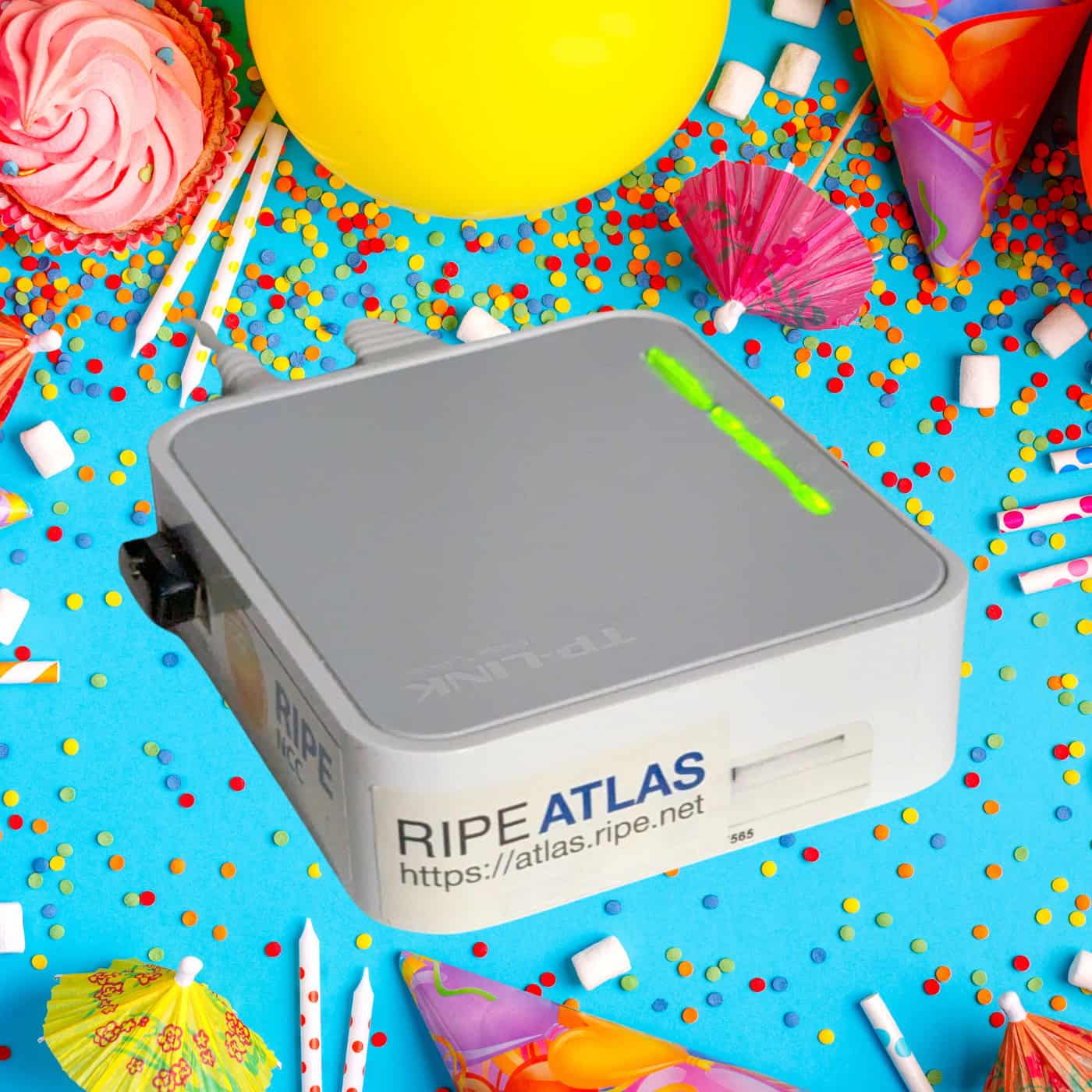I just got an email from RIPE NCC that made me smile. It was a “birthday” message for my RIPE Atlas probe – celebrating 12 years of continuous operation with an impressive 89.69% uptime. Along with the congratulations came over 10 million credits to spend on custom measurements! Not a bad return on investment for what amounts to plugging in a small device and forgetting about it.
But this email got me thinking. Many folks in our industry probably don’t know about RIPE Atlas, and those who do might not fully appreciate what they’re missing by not participating. So let me tell you why hosting a probe is one of the smartest things you can do for yourself, and for the Internet at large.
What Exactly is RIPE Atlas?
RIPE Atlas is a global, open, distributed Internet measurement platform, consisting of thousands of measurement devices that measure Internet connectivity in real time. RIPE Atlas was established in 2010 by the RIPE Network Coordination Centre (NCC), and it’s grown into something remarkable: around 12,000 probes and more than 800 anchors around the world.
Think of it as the Internet’s nervous system. These devices are constantly taking the pulse of global connectivity; measuring latency, tracing routes, checking DNS resolution, and monitoring reachability. The result? An unprecedented view of how the Internet actually works, in real time, from thousands of vantage points.
The concept is elegantly simple; volunteers host small measurement devices that continuously monitor Internet performance. In return, they earn credits to conduct their own measurements from this global network. It’s a beautiful example of collective intelligence in action.
Why This Matters for Network Folks
If you’ve ever had to troubleshoot a connectivity issue and wished you had eyes in different parts of the world, RIPE Atlas is your answer. The platform provides a comprehensive API that allows you to integrate measurement data into your existing monitoring and alerting systems. You can schedule ping measurements from thousands of probes around the world to look at your network from the outside.
Here are some real scenarios:
- Getting reports of intermittent connectivity from users, and need to understand if the problem is localized, regional, or global? With RIPE Atlas, you can quickly schedule measurements from probes worldwide to see exactly where the problem lies.
- Planning to change DNS providers? Test resolution times from different regions before making the switch.
- Evaluating a new CDN or transit provider? Compare performance metrics from thousands of vantage points.
- For routing problems, you can select probes by AS to understand if problems are network-specific or more widespread.
- Even during network incidents, you can assess which regions are affected and which paths remain functional.
It’s like having a distributed team of network engineers running tests for you 24/7.
The Credit Economy
Here’s where it gets interesting: Every probe you host earns you credits. A host receives 15 credits for each minute that their probe is connected to our network, so assuming that your probe is connected continuously, you should earn roughly 21,600 credits every 24 hours.
To put that in perspective, with 1,000,000 credits, you could schedule pings from 50 probes worldwide to run every five minutes for three weeks. After hosting a probe for just a couple of months, you’d have enough credits for extensive troubleshooting campaigns or ongoing monitoring projects.
This isn’t just theoretical. Organizations like DigitalOcean use the platform to test and validate access to their data centers from thousands of locations around the world in just minutes. When you think about the cost of setting up global monitoring infrastructure yourself versus plugging in a single probe, the economics are compelling.
Two Ways to Get Started
Hardware Probes: The “Set and Forget” Option
Hardware probes need less technical knowledge to install and operate because they are install and forget. Once the device is in place, it automatically connects and in general ‘just works’. They automatically updated to use the newest available firmware.
The process is straightforward:
- Create a RIPE NCC Access account
- Apply for a hardware probe through your account
- If your application is approved, they’ll send you a probe
- Register your probe through your account and plug it in
That’s it. The probe handles everything else, including firmware updates and connectivity management.
Software Probes: For the Technically Inclined
Software probes need more technical knowledge but can be installed on a number of Linux variants (Debian, RedHat, OpenWrt, Raspberry). You supply the hardware (can be a VM as well) to run on a home router, a Pi laying around, your own server, etc.
This option gives you more control and flexibility, though it requires more hands-on management when updates are released.
Additional Applications
Sure, you can use RIPE Atlas for network troubleshooting and monitoring. But the potential goes deeper than that.
Research and Analysis: The platform has become invaluable for Internet research. RIPE Atlas has been used to study major Internet events, including an outage at the Amsterdam Internet Exchange (AMS-IX), generally considered one of the largest IXPs on the planet.
Performance Validation: Before making infrastructure decisions, you can test performance from various global locations. Planning a new CDN deployment? Changing providers? RIPE Atlas gives you the data to make informed decisions.
Learning and Development: If you’re building your network automation skills, RIPE Atlas provides an excellent API and dataset to practice with. The measurement data is rich and the API is well-documented.
The Community Aspect
This isn’t just about individual benefit. RIPE Atlas Ambassadors help distribute probes and expand the RIPE Atlas network so that the entire Internet community can benefit from the data collected about Internet performance. By hosting a probe, you’re contributing to something larger than yourself.
The vast majority of all data that RIPE Atlas collects is freely available. You don’t need to host a probe or even to have a RIPE NCC Account to browse, download or use this data. Your probe contributes to this shared resource that researchers, operators, and policy makers use to understand Internet behavior.
Why I’m Writing This Now
Getting that birthday email reminded me of something important: The best infrastructure investments are the ones you make once and benefit from for years. My probe has been quietly earning credits and contributing data for over a decade. The initial setup took maybe 30 minutes, and since then it’s been completely hands-off.
In our industry, we’re always looking for ways to get better visibility into network performance, to troubleshoot more effectively, and to make data-driven decisions. RIPE Atlas provides all of that, for free, in exchange for hosting a small device that uses minimal power and bandwidth.
The Bottom Line
Whether you’re a network engineer looking to expand your troubleshooting capabilities, a researcher studying Internet behavior, or someone who simply wants to contribute to Internet infrastructure, hosting a RIPE Atlas probe is a no-brainer.
The barrier to entry is low, the ongoing maintenance is essentially zero, and the benefits (both personal and collective) are substantial. There are over 12,000 RIPE Atlas probes in the network and that number is growing; but we could always use more coverage, especially in underrepresented regions.
Ready to join? Head over to atlas.ripe.net to get started. And if you’re already hosting a probe, consider becoming an ambassador to help spread the word. The Internet’s nervous system is only as good as its coverage, and every new probe makes the whole system more valuable for everyone.
Trust me, in twelve years you’ll get your own birthday email, and you’ll be glad you took the first step.






